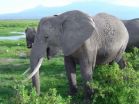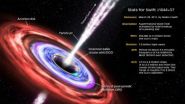(Press-News.org) African elephants are known to be great communicators that converse with extremely low-pitched vocalizations, known as infrasounds, over a distance of miles. These infrasounds occupy a very low frequency range—fewer than 20 Hertz, or cycles, per second—that is generally below the threshold of human hearing.
Now, a new study shows that elephants rely on the same mechanism that produces speech in humans (and the vocalizations of many other mammals) to hit those extremely low notes. Christian Herbst from the University of Vienna, along with colleagues from Germany, Austria and the United States, used the larynx of a recently deceased elephant to recreate some elephant infrasounds in a laboratory.
Their findings are published in the 3 August issue of the journal Science, which is published by AAAS, the nonprofit science society.
"These vocalizations are called infrasounds because their fundamental frequency is below the range of human hearing," explained Herbst during a phone interview. "We only hear the harmonics of such sounds, or multiples of that fundamental frequency. If an elephant's vocal folds were to clap together at 10 Hertz, for example, we would perceive some energy in that sound at 20, 30, 40 Hertz and so on. But these higher overtones are usually weaker in amplitude."
Until now, researchers have wondered whether these low, rumbling elephant infrasounds were created by intermittent muscle contractions, as a cat's purr is, or by flow-induced vocal fold vibrations, fueled by air from the lungs, as is a human's voice. But, the natural death of an elephant at a zoo in Berlin gave Herbst and his colleagues a somewhat serendipitous chance to study the mechanism firsthand.
The researchers removed the elephant's larynx and froze it within a few hours of the animal's death. They then took it over to the larynx laboratory in the Department of Cognitive Biology at the University of Vienna, where Tecumseh Fitch, a senior author of the Science paper, studied it in depth.
Herbst and the other researchers imitated the elephant's lungs by blowing controlled streams of warm, humid air through the excised larynx while adjusting the elephant vocal folds into a phonatory, or vocal-ready, position. In this way, the scientists were able to coax the vocal folds into a periodic, low-frequency vibration that matched an elephant's infrasound in every detail.
The fact that they were able to duplicate the elephant's infrasounds in a laboratory demonstrates that the animals rely on a myoelastic-aerodynamic, or "flow-driven," mode of speech to communicate in the wild. The elephant's brain would have been required to recurrently tense and relax the vocal muscles if the other mechanism, which produces a cat's purr, was involved, they say.
This flow-induced mechanism demonstrated by the researchers is likely to be employed by a wide range of mammals. From echolocating bats with their incredibly high vocalizations to African elephants and their extremely low-pitched infrasounds, this mode of voice production seems to span four to five orders of magnitude across a wide range of body sizes and sonic frequencies.
The researchers also saw some interesting "nonlinear phenomena" in the way the elephant vocal folds vibrated. These mostly irregular patterns of vibration occur when babies cry or heavy metal singers scream and the physical mechanism that elephants use is again identical to that seen in humans, they say.
"If I scream, it's no longer a periodic vibration," said Herbst. "It becomes chaotic and you can hear a certain degree of roughness. This can also be observed in young elephants, in situations of high excitement."
Herbst says that the findings were only made possible by a collaborative effort between voice scientists and biologists, and that voice science is an essential aspect of our social and economic lives.
INFORMATION:
The report by Herbst et al. was supported by European Research Council Advanced Grant SOMACCA, a startup grant from the University of Vienna, an Austrian Science Fund grant, a grant from the Deutsche Forschungsgemeinschaft, and a grant from the National Institute for Deafness and Other Communication Disorders.
The American Association for the Advancement of Science (AAAS) is the world's largest general scientific society, and publisher of the journal, Science (www.sciencemag.org) as well as Science Translational Medicine (www.sciencetranslationalmedicine.org) and Science Signaling (www.sciencesignaling.org). AAAS was founded in 1848, and includes some 262 affiliated societies and academies of science, serving 10 million individuals. Science has the largest paid circulation of any peer-reviewed general science journal in the world, with an estimated total readership of 1 million. The non-profit AAAS (www.aaas.org) is open to all and fulfills its mission to "advance science and serve society" through initiatives in science policy; international programs; science education; and more. For the latest research news, log onto EurekAlert!, www.eurekalert.org, the premier science-news Web site, a service of AAAS.
Study shows how elephants produce their deep 'voices'
The same physical mechanism produces vocalizations in elephants and humans
2012-08-03
ELSE PRESS RELEASES FROM THIS DATE:
NASA satellites see Tropical Storm Saola and Typhoon Damrey arm-in-arm near China
2012-08-03
Tropical Storm Saola and Typhoon Damrey appear on NASA satellite imagery to be arm-in-arm as they enter China on August 2.
NASA's Terra satellite passed over both tropical cyclones and captured them in one image, using the Moderate Resolution Imaging Spectroradiometer (MODIS) instrument onboard. MODIS captured a visible image on August 2, 2012 at 0245 UTC that showed the southern extent (or arm) of Typhoon Damrey, making landfall north of Shanghai, feeding into the northern extent (or arm) of Tropical Storm Saola, making landfall south of Shanghai. MODIS imagery also ...
Bacteria-immune system 'fight' can lead to chronic diseases, study suggests
2012-08-03
ATLANTA – Results from a study conducted at Georgia State University suggest that a "fight" between bacteria normally living in the intestines and the immune system, kicked off by another type of bacteria, may be linked to two types of chronic disease.
The study suggests that the "fight" continues after the instigator bacteria have been cleared by the body, according to Andrew Gewirtz, professor of biology at the GSU Center for Inflammation, Immunity and Infection. That fight can result in metabolic syndrome, an important factor in obesity, or inflammatory bowel disease ...
Research could lead to improved oil recovery, better environmental cleanup
2012-08-03
CORVALLIS, Ore. – Researchers have taken a new look at an old, but seldom-used technique developed by the petroleum industry to recover oil, and learned more about why it works, how it could be improved, and how it might be able to make a comeback not only in oil recovery but also environmental cleanup.
The technology, called "microbial enhanced oil recovery," was first developed decades ago, but oil drillers largely lost interest in it due to its cost, inconsistent results and a poor understanding of what was actually happening underground.
The new findings by engineers ...
New target for treating diabetes and obesity
2012-08-03
AUDIO:
Researchers at Washington University School of Medicine in St. Louis have identified a potential target for treating diabetes and obesity. They discovered that when a particular protein is disabled in...
Click here for more information.
Researchers at Washington University School of Medicine in St. Louis have identified a potential target for treating diabetes and obesity.
Studying mice, they found that when the target protein was disabled, the animals became more ...
Judging the role of religion in law
2012-08-03
There's a passage in the Old Testament's Deuteronomy that says if a case too difficult to decide comes before the courts, it should be brought to the Levite priests who will render a verdict in God's name. However, one University of Alberta researcher says that may be taking religious freedom a step too far.
Sarah Hamill, a doctoral student in the Faculty of Law, recently published an article in response to a premise that said judges who lack direction-setting precedence in cases should use religious-based reasoning. Hamill contends that—aside from being a serious breach ...
Deep-sea squid can 'jettison arms' as defensive tactic
2012-08-03
KINGSTON, R.I. – August 2, 2012 – A postdoctoral researcher at the University of Rhode Island has observed a never-before-seen defensive strategy used by a small species of deep-sea squid in which the animal counter-attacks a predator and then leaves the tips of its arms attached to the predator as a distraction.
Stephanie Bush said that when the foot-long octopus squid (Octopoteuthis deletron) found deep in the northeast Pacific Ocean "jettisons its arms" in self-defense, the bioluminescent tips continue to twitch and glow, creating a diversion that enables the squid ...
Vaporizing the Earth
2012-08-03
In science fiction novels, evil overlords and hostile aliens often threaten to vaporize the Earth. At the beginning of The Hitchhikers Guide to the Galaxy, the officiously bureaucratic aliens called Vogons, authors of the third-worst poetry in the universe, actually follow through on the threat, destroying the Earth to make way for a hyperspatial express route.
"We scientists are not content just to talk about vaporizing the Earth," says Bruce Fegley, professor of earth and planetary sciences at Washington University in St. Louis, tongue firmly in cheek. "We want to understand ...
'Cry' of a shredded star heralds a new era for testing relativity
2012-08-03
Last year, astronomers discovered a quiescent black hole in a distant galaxy that erupted after shredding and consuming a passing star. Now researchers have identified a distinctive X-ray signal observed in the days following the outburst that comes from matter on the verge of falling into the black hole.
This tell-tale signal, called a quasi-periodic oscillation or QPO, is a characteristic feature of the accretion disks that often surround the most compact objects in the universe -- white dwarf stars, neutron stars and black holes. QPOs have been seen in many stellar-mass ...
Extinction risk factors for New Zealand birds today differ from those of the past
2012-08-03
Durham, NC – What makes some species more prone to extinction? A new study of nearly 300 species of New Zealand birds — from pre-human times to the present — reveals that the keys to survival today differ from those of the past.
The results are important in light of the growing number of studies that try to predict which species could be lost in the future based on what kinds of species are considered most threatened today, said lead author Lindell Bromham of Australian National University.
In the roughly 700 years since humans arrived in the remote islands that make ...
Notre Dame research into oaks helps us understand climate change
2012-08-03
Jeanne Romero-Severson, associate professor of biological sciences at the University of Notre Dame, and her collaborators, are tracking the evolution of the live oaks of eastern North America, seeking to understand how the trees adapted to climate change during glacial periods.
When the ice advanced, the oaks retreated. When the ice retreated the oaks advanced, spreading from tropical to temperate zones, up from Central America and Mexico into the Piedmont Carolinas. The researchers expect the study of live oak migrations and phylogeny will provide clues to the success ...
LAST 30 PRESS RELEASES:
$80 million in donations propels UCI MIND toward world-class center focused on dementia
Illinois research uncovers harvest and nutrient strategies to boost bioenergy profits
How did Bronze Age plague spread? A sheep might solve the mystery
Mental health professionals urged to do their own evaluations of AI-based tools
Insufficient sleep associated with decreased life expectancy
Intellicule receives NIH grant to develop biomolecular modeling software
Mount Sinai study finds childhood leukemia aggressiveness depends on timing of genetic mutation
RSS Research Award for new lidar technology for cloud research
Novel AI technique able to distinguish between progressive brain tumours and radiation necrosis, York University study finds
Why are abstinent smokers more sensitive to pain?
Alexander Khalessi, MD, MBA, appointed Chief Innovation Officer
Optical chip pioneers physical-layer public-key encryption with partial coherence
How your brain understands language may be more like AI than we ever imagined
Missed signals: Virginia’s septic strategies overlook critical timing, study warns
Delayed toxicities after CAR T cell therapy for multiple myeloma are connected and potentially preventable
Scientists find cellular key to helping plants survive in saltwater
Medical cannabis program reduces opioid use
Immunotherapy works for sepsis thanks to smart patient selection
Cardiovascular events 1 year after RSV infection in adults
US medical prices and health insurance premiums, 1999-2024
Medical cannabis and opioid receipt among adults with chronic pain
Multichannel 3D-printed bioactive scaffold combined with siRNA delivery for spinal cord injury recovery
Triaptosis—an emerging paradigm in cancer therapeutics
A new paradigm in spectroscopic sensing: The revolutionary leap of SERS-optical waveguide integration and ai-enabled ultra-sensitive detection
Sweet tooth: How blood sugar migration in diabetes affects cavity development
Lowest suicide rate is in December but some in media still promote holiday-suicide myth
Record-breaking cosmic explosion challenges astronomers’ understanding of gamma-ray bursts
Excessive heat harms young children’s development, study suggests
Quanta Books to publish popular math and physics titles by Terence Tao and David Tong
Philanthropic partnerships fund next-generation instruments for mid-sized telescopes
[Press-News.org] Study shows how elephants produce their deep 'voices'The same physical mechanism produces vocalizations in elephants and humans




